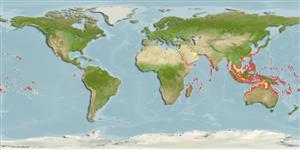Common names from other countries
Environment: milieu / climate zone / depth range / distribution range
Ecologia
marinhas associadas(os) a recifes; intervalo de profundidade 0 - 48 m (Ref. 58302), usually ? - 10 m (Ref. 30404). Tropical; 32°N - 33°S, 27°E - 76°W
Indo-Pacific: Red Sea and East Africa (Ref. 33390) and Persian Gulf (Ref. 68964) to the Society Islands, north to southern Japan and the Hawaiian Islands, south to Lord Howe Island; throughout Micronesia. Eastern Central Pacific: southern Baja California, Mexico and from Costa Rica to northern Colombia (Ref. 9324). Also found in Southeast Atlantic.
Tamanho / Peso / Idade
Maturity: Lm ? range ? - ? cm
Max length : 100.0 cm TL macho/indeterminado; (Ref. 48635); common length : 50.0 cm TL macho/indeterminado; (Ref. 3258)
Espinhos dorsais (total) : 0; Raios dorsais moles (total) : 0; Espinhos anais: 0; Raios anais moles: 0; Vértebras: 119 - 126. Body white with 2 rows of large dendritic black blotches; black spots between blotches become irregularly linear with age. Yellow eyes (Ref. 48635).
Found between rocks and corals of intertidal reef flats, also in shallow lagoon and seaward reefs to depths of at least 10 m (Ref. 9710, 58302). Benthic (Ref. 58302). Nocturnal (Ref. 68964). Feed mainly on crustaceans. Protogynous hermaphroditism unconfirmed for this species (Ref. 84746). Safely kept with small aquarium fishes (Ref. 9710). Solitary, seen usually in the open or with only head exposed (Ref 90102). Minimum depth reported taken from Ref. 86942.
Life cycle and mating behavior
Maturities | Reprodução | Spawnings | Egg(s) | Fecundities | Larvas
Protogyny unconfirmed (Ref. 84746).
Chen, H.-M., K.-T. Shao and C.T. Chen, 1994. A review of the muraenid eels (Family Muraenidae) from Taiwan with descriptions of twelve new records. Zool. Stud. 33(1):44-64. (Ref. 6934)
Categoria na Lista Vermelha da IUCN (Ref. 130435)
CITES (Ref. 128078)
Not Evaluated
Ameaça para o homem
Harmless
Utilização humana
Pescarias: pouco comercial; Aquário: Espécies comerciais
Ferramentas
Relatórios especiais
Descarregue XML
Fontes da internet
Estimates based on models
Preferred temperature (Ref.
115969): 24.9 - 29.3, mean 28.4 (based on 3674 cells).
Phylogenetic diversity index (Ref.
82804): PD
50 = 0.5005 [Uniqueness, from 0.5 = low to 2.0 = high].
Bayesian length-weight: a=0.00034 (0.00022 - 0.00052), b=3.31 (3.19 - 3.43), in cm Total Length, based on LWR estimates for this species & (Sub)family-body (Ref.
93245).
Nível Trófico (Ref.
69278): 4.2 ±0.71 se; based on food items.
Resiliência (Ref.
120179): Baixo, tempo mínimo de duplicação da população 4,5 - 14 anos (Preliminary K or Fecundity.).
Fishing Vulnerability (Ref.
59153): High vulnerability (60 of 100).
